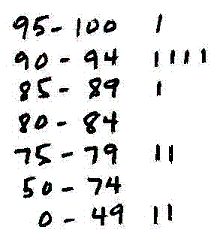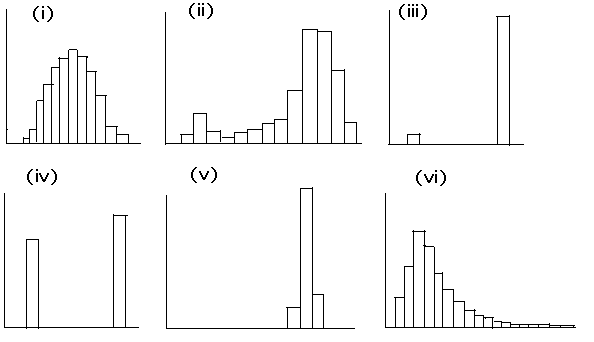- Experimental Trials for the Salk Polio Vaccine
- Forecasting the 1936 Presidential Election
- Statistical Experiments vs. Observational Studies
What do Statisticians Do?
- Reference: The Statistics in Practice articles on the CD
that comes with your textbook:
- Jennifer Karas, Marketing Research: A Voice for Consumers
- Cynthia Perez, Tracking Disease in Puerto Rico
- Tommy Wright, Sampling the Nation
- Jaime Sam Mart'in, Research in Probability Theory
- Jing Shyr, Statistical Software for Solving Business Problems
- Marcey Abate, Testing Nuclear Weapons without Explosions
- Iogn' Aido' Murcheartaigh, From p-values to President
- Aarti Ssiram, Management Consulting
- Rebecca Doerge, Finding Genes in Plants and People
- Gregory Campbell, Making Sure Medical Devices are Safe and Effective
- Dexter Wilson, Improving the Quality of a Bank's Services
- Christopher Presley, Statistics for Science, and More
- Steve Sun, Developing New Drugs
Exploratory Data Analysis
- The term Exploratory Data Analysis or EDA was coined by John Tukey.
- Although EDA is usually associated with techniques like stemplots and boxplots, it is more accurately defined as a philosophy: understand the dataset before deciding which statistical tests to perform.
- Some terminology:
- A univariate dataset is a dataset containing only one variable.
For example these hypothetical exam scores form a univariate dataset:
-
98
93
85
39
91
75
5
93
79
90
- A bivariate dataset is a dataset containing two variables. Some examples of bivariate datasets are weight vs. height, price vs. date, and score on exam vs. hours studied for it.
- A multivariate dataset is a dataset containing two or more variables.
- A nominal variable (also called a categorical variable) is a variable that contains non-numeric values, such as gender (female, male), is-smoker (yes, no), position (offense, defense), coin-condition (Poor, Fair/Good, F, VF, EF, UNC, BU).
- A scale variable (also called a quantitative variable or continuous variable) is a variable that can contain any value in a continuous range. Examples are: age, height, weight, gpa, price.
- An ordinal variable is a variable that contains discrete numeric values. Examples are: college-year (1, 2, 3, 4), survey-answer (1, 2, 3, 4, 5).
- To summarize the various value of a univariate dataset, tally marks
are traditionally used. Here are the sorted hypothetical exam scores:
-
5 39 75 79 85
90 91 93 93 98
- Here is the tally diagram:

- A more informative technique is the stemplot, also called the
stem-and-leaf display.
95 | 8 90 | 0133 85 | 5 80 | 75 | 59 70 | 65 | 60 | 55 | 50 | 45 | 40 | 35 | 9 30 | 25 | 20 | 15 | 10 | 5 | 5 0 |
The last digit of each observation is recorded to the right of the vertical line down the middle, which is the "stem." - Histograms
- A univariate dataset is a dataset containing only one variable.
For example these hypothetical exam scores form a univariate dataset:
Quartiles
- The Quartiles divide the sorted dataset into fourths.
- Q0 is the minimum point in the dataset. Approximately 0/4 (none) of the data are less than than Q0.
- Q4 is the maximum point in the dataset. Approximately 4/4 (all) of the data are less than than Q4.
- Q2 is the median (middle point) of the dataset. Approximately 2/4 = 1/2 of the data are less than than Q2. If the dataset has an even number of observations, the Q2 is the average of the middle two observations.
- Q1 is the median of the bottom half of the data. (If the dataset has an odd number of observations, the bottom half of the data contains the middle observation). Approximately 1/4 of the data are below Q1.
- Q3 is the median of the top half of the data. (If the dataset has an odd number of observations, the top half of the data contains the middle observation). Approximately 3/4 of the data are below Q3.
- Q1, Q2, and Q3 and also called the 25th, 50th, and 75th percentiles, respectively.
- Exercise: Find the quartiles of the hypothetical exam scores:
- 5 39 75 79 85 90 91 93 93 98
- The interquartile range (IQR), is defined as IQR = Q3 - Q1.
- Here are some alternative ways to compute percentiles.
- There are at least different eight methods for computing precentiles.
- Boxplots
Practice Problems
- Match the descriptions with the histograms below:
- The gender of all persons in a college class (male = 0, female = 1).
- The handedness of all persons in a college class (left handed = 0, right handed = 1).
- The heights of all married persons counted separately.
- The heights of all persons in families where both parents are 28 years old or less.
- The heights of all automobiles.
- The incomes of all persons in the U.S.

Ans: 1 iv, 2 iii, 3 i, 4 ii, 5 v, 6 vi.
Using SPSS
- Use SPSS to complete Project 1 in the computer lab after the break.
- Use the reference documents found on the Documents Page.
- How do you make a histogram when the variable is categorical? Solution: create a bar graph.
Project 2
- Look at Project 2a.
- Start thinking about what data you want to collect for Project 2.